4.4 Theories of Infant Psychosocial Development
We now consider again the theories discussed in Chapter 1 in greater depth. As you will see, theories lead to insight and applications, preparing us for the final topic of this chapter, non-
Psychoanalytic Theory
ESPECIALLY FOR Nursing Mothers You have heard that if you wean your child too early, he or she will overeat or become an alcoholic. Is it true? 
Freud thought so, but there is no experimental evidence that weaning, even when ill-timed, has such dire long-term effects. 
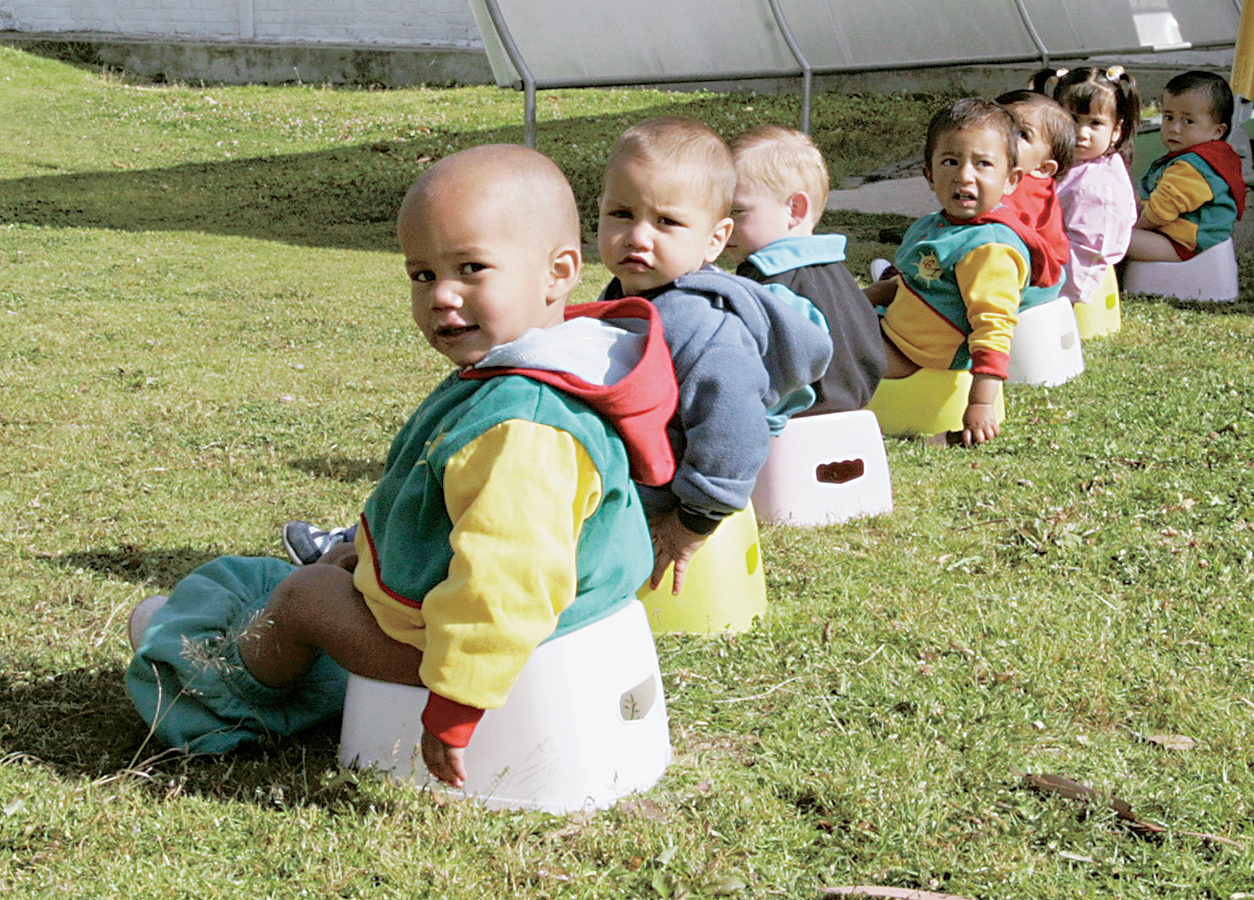
Psychoanalytic theory connects biosocial and psychosocial development. Sigmund Freud and Erik Erikson each described two distinct stages of early development. Freud (1935, 1940/1964) wrote about the oral stage and the anal stage. Erikson (1963) called his first stages trust versus mistrust and autonomy versus shame and doubt.
158
Freud: Oral and Anal StagesAccording to Freud (1935), the first year of life is the oral stage, so named because the mouth is the young infant’s primary source of gratification. In the second year, with the anal stage, the infant’s main pleasure comes from the anus—
Freud believed that the oral and anal stages are fraught with potential conflicts that have long-
Similarly, if toilet training is overly strict or if it begins before the infant is mature enough, parent and infant may become locked in a conflict over the toddler’s refusal, or inability, to comply. The child develops an anal personality and becomes an adult who seeks self-
Erikson: Trust and AutonomyAccording to Erikson, the first psychosocial crisis of life is trust versus mistrust, when infants learn whether the world can be trusted to satisfy basic needs. Babies feel secure when food and comfort are provided with “consistency, continuity, and sameness of experience” (Erikson, 1963). If social interaction inspires trust, the child (later the adult) confidently explores the social world.
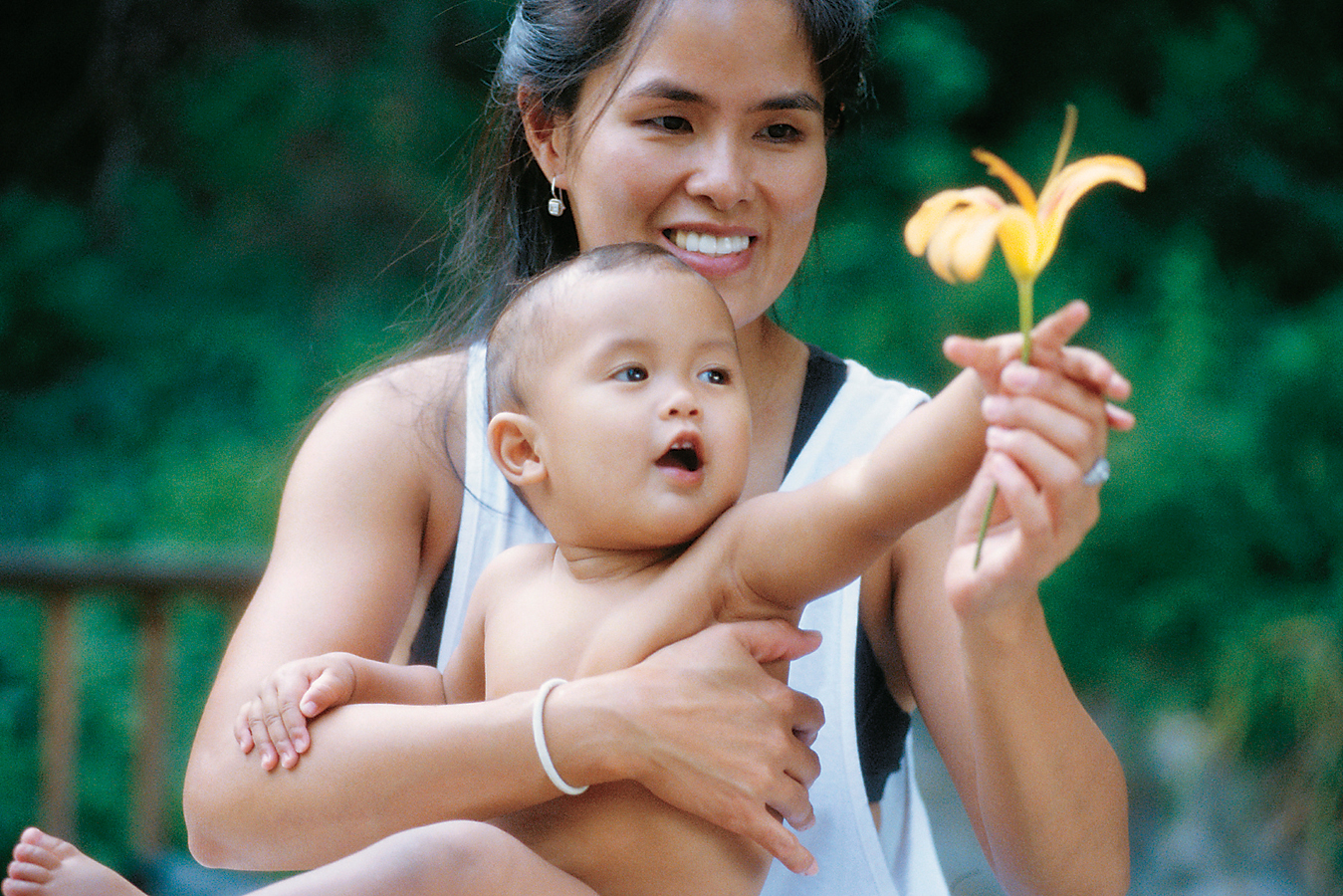
The second crisis is autonomy versus shame and doubt, beginning at about 18 months, when self-
Erikson was aware of cultural variations. He knew that mistrust and shame could be destructive or not, depending on norms and expectations of each ethnic group and family. Some cultures encourage independence and autonomy; in others, “shame is a normative emotion that develops as parents use explicit shaming techniques” to encourage children’s loyalty and harmony within their families (Mascolo et al., 2003).
Learning Theory
According to learning theory, even very young children pick up behavioural cues from those around them. Behaviourism focuses on the way parents use positive and negative reinforcements as the means of shaping a child’s behaviour. In contrast, social learning theory stresses the way that children learn to behave by observing and imitating their parents and other adults.
BehaviourismFrom the perspective of behaviourism, emotions and personality are shaped as parents reinforce or punish a child. Behaviourists believe that parents who respond joyously to every glimmer of a grin will have children with a sunny disposition. The opposite is also true:
159
Failure to bring up a happy child, a well-
[Watson, 1928]

Social Learning TheoryLater behaviourists recognized that infants’ behaviour also has an element of social learning, through which infants learn from the people around them. Albert Bandura conducted a classic experiment (Bandura, 1977) in which young children were frustrated by being told they could not play with some attractive toys; they were then left alone with a mallet and a rubber toy clown (Bobo) after seeing an adult hit the toy. Both boys and girls pounded and kicked Bobo as the adult had done, indicating that they had learned from observation.
Since that experiment, developmentalists have demonstrated that social learning occurs throughout life (Morris et al., 2007; Nielsen, 2006). In many families, toddlers express emotions in various ways—
Social learning theorists acknowledge inborn temperament but stress that children follow the role models they see. Shyness may be inborn, for instance, but parents who model social interaction, greeting their many friends warmly, will help a withdrawn child become more outgoing (Rubin et al., 2009). Often parents unwittingly encourage certain traits in their children by how they respond to their infants. This is evident in the effects of proximal versus distal parenting, as you will now learn.
Cognitive Theory
Cognitive theory holds that thoughts and values determine a person’s perspective. Early experiences are important because beliefs, perceptions, and memories make them so, not because they are buried in the unconscious (psychoanalytic theory), or are the result of repeated reinforcement (behaviourism).
According to many cognitive theorists, early experiences help infants develop a set of assumptions that become a frame of reference for later in life. This set of assumptions is known as a working model (Johnson et al., 2010). It is a “model” because early relationships form a prototype, or blueprint, for later interactions; it is “working” because, although it is used, it is not necessarily fixed or final, but is modified as new information becomes available.
160
OPPOSING PERSPECTIVES
Proximal and Distal Parenting
Should a parent carry an infant most of the time, or will that spoil the baby? Should babies have a large number of toys, or will that make them too materialistic?
These questions refer to the distinction between proximal parenting (being physically close to a baby, often holding and touching) and distal parenting (keeping some distance—
The research finds notable cultural differences, not only with newborns but also with older children (Keller et al., 2010). For example, a longitudinal study comparing child-
| Cameroon | Athens, Greece | |
|---|---|---|
| I. Infant– |
||
| Percent of time held by mother | 100% | 31% |
| Percent of time playing with objects | 3% | 40% |
| II. Toddler behaviour at 18 months | ||
| Self- |
3% | 68% |
| Immediate compliance with request | 72% | 2% |
| Source: Adapted from Keller et al., 2004. | ||
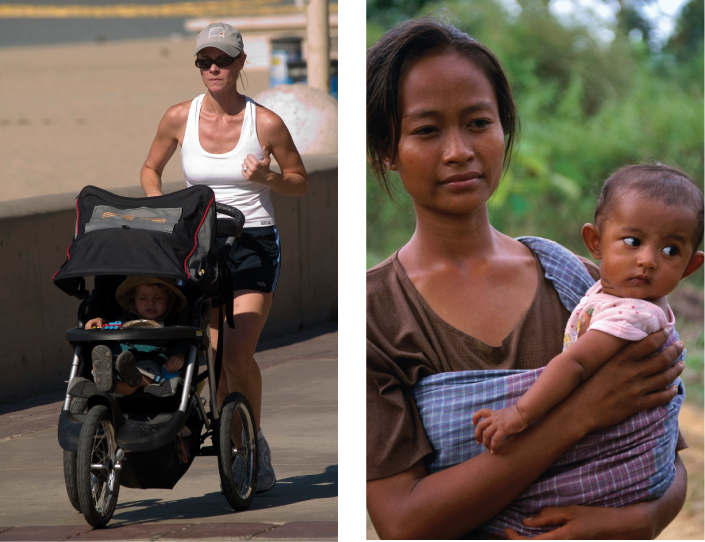
DAWN DELANEY/LONELY PLANET/GETTY IMAGES
The researchers hypothesized that proximal parenting would result in toddlers who were less self-
The predictions were accurate. At 18 months, these same infants were tested on self-
161
Replicating their own work, the researchers studied a dozen mother—
The researchers then reanalyzed all their data, child by child. They found that, even apart from culture, proximal or distal play at 3 months was highly predictive: Greek mothers who, unlike most of their peers, were proximal parents had more obedient toddlers. Further research in several other nations confirmed the consequences of these two forms of parenting (Borke et al., 2007; Kärtner et al., 2011).
For every aspect of infant care, cultural attitudes have some impact, but for the proximal/distal response, culture is especially pivotal. Is independence valued over dependence, Is autonomy more important than compliance? Cultures differ in their answers. If a mother asks her toddler to put away some toys that he or she did not use (a test sometimes used to measure compliance), and the toddler puts them away without protest, is that wonderful or disturbing?
Answers may depend on whether rebellious independence or law-
ESPECIALLY FOR Statisticians Note the sizes of the samples in TABLE 4.3 and in the description of the Costa Rica study: 78 mother–
Probably not. These studies are reported here because the results were dramatic (see TABLE 4.3) and because the two studies pointed in the same direction. Nevertheless, replication by other researchers is needed. 
Ideally, infants develop a working model of the self as valued, loved, and competent and a working model of parents as emotionally available, loving, sensitive and supportive (Harter, 2006). However, reality does not always conform to this ideal. A 1-
ESPECIALLY FOR Pediatricians A mother complains that her child refuses to stay in the car seat, spits out disliked foods, and almost never does what she says. How should you respond? 
Consider the origins of the misbehaviour—it may be a combination of the child’s inborn temperament and the mother’s distal parenting. That could contribute to the child’s being stubborn and independent. Acceptance is more warranted than anger. 
To use Piaget’s terminology, such a girl develops a cognitive schema to organize her perceptions. According to cognitive theory, an infant’s early experiences are not themselves necessarily crucial, but the interpretation of those experiences is (Olson & Dweck, 2009). In this way, working models formed in childhood echo for a lifetime. A hopeful message from cognitive theory is that people can rethink and reorganize their thoughts, developing new models. Our mistrustful girl might marry a faithful and loving partner and gradually develop a better working model.
Systems Theory
As you read in Chapter 1, family systems theory focuses on the family as a unit in which each member has a certain role and a number of responsibilities. Because Bowlby’s primary agenda with attachment theory was to challenge his psychoanalytic colleagues’ assumptions that children only love their mothers because they provide oral gratification, Bowlby overlooked fathers.
Michael Lamb (1976), a leading researcher in the field of fathering, conducted a series of experiments evaluating infants’ attachment with mothers and fathers. Lamb found that infants’ level of approach to and contact-
Recently, researchers have focused especially on fathers and on the way their roles and responsibilities have changed over time. For example, fathers now share caregiving responsibilities with mothers instead of primarily being as the economic breadwinner in the family. One reason for this is that the mother’s role has changed too, since many mothers are now contributing to the household income through their own careers (Chuang, 2009).
162
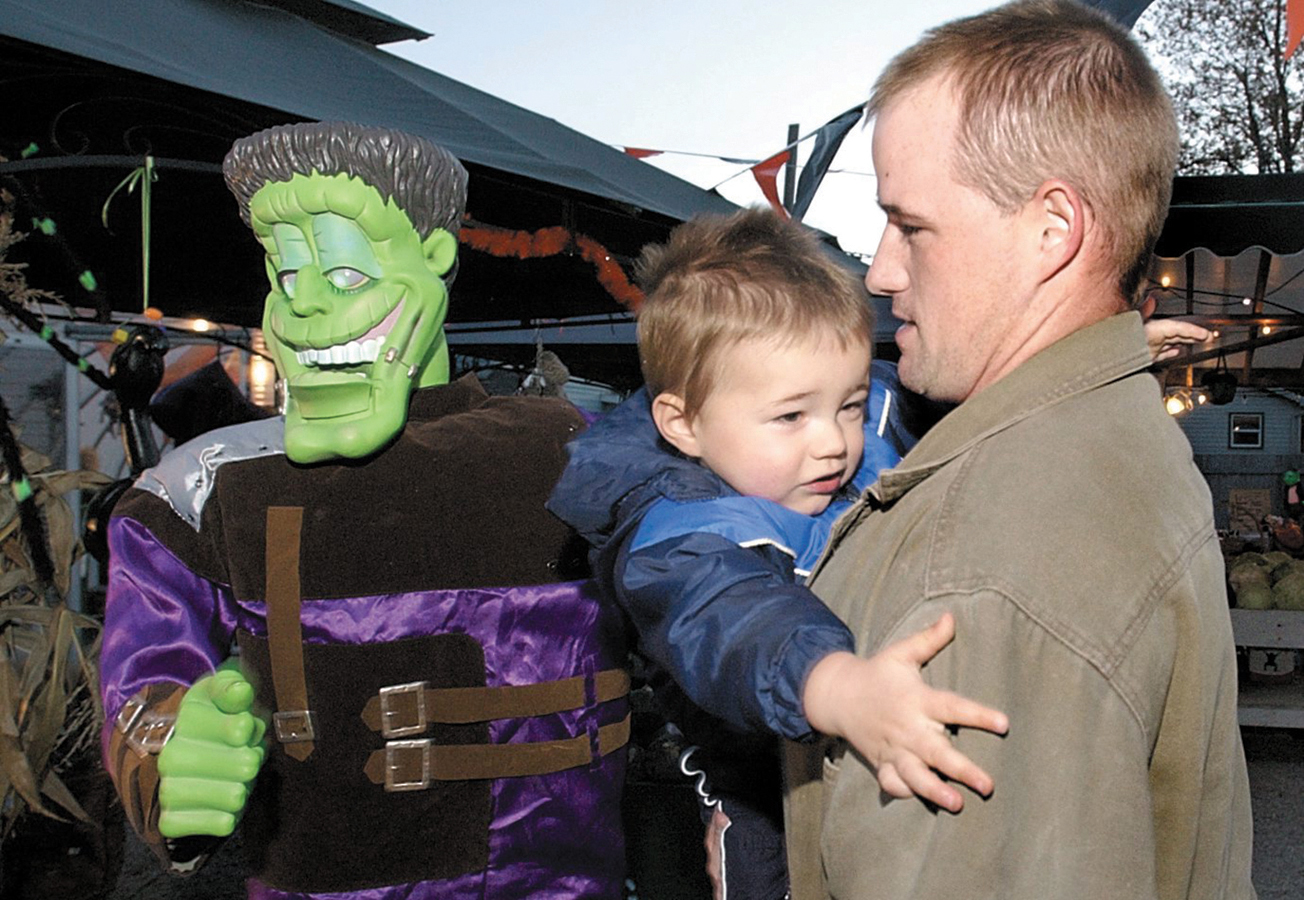
According to Statistics Canada (2010c), although fathers are assuming more caregiving duties than in the past, mothers still spend more time on average in this role than fathers. For example, in 2010, women with children 4 years and younger spent 6 hours 33 minutes per day as caregivers compared with fathers spending 3 hours 7 minutes.
Humanism
Remember that Maslow described a hierarchy of needs (physiological, safety/security, love/belonging, success/esteem, and self-
Humanism reminds us that caregivers also have needs, and their needs influence how they respond to infants. Self-
For example, although all experts endorse breastfeeding as the best way to meet infants’ physiological needs, many mothers stop breastfeeding after trying for a few days, and many fathers feel excluded if the mother spends most of her time and attention on nursing. This may puzzle the experts but not the humanist theorists, who realize that a parent’s needs may clash with the infant’s needs (Mulder & Johnson, 2010). For instance, one mother of a 1-
My son couldn’t latch so I was pumping and my breasts were massive and I’m a pretty small woman with big breasts and they were enormous during pregnancy. It has always been a sore spot for me and I’ve never loved my breasts. And that has been hard for me in not feeling good about myself. And I stopped pumping in January and slowly they are going back and I’m beginning to feel some confidence again and that definitely helps. Because I felt overweight, your boobs are not your own and you are exhausted and your body is strange it’s just really hard to want to share that with someone. They think you are beautiful, they love it and love you the way you are but it is not necessarily what you feel.
[quoted in Shapiro, 2011]
163
This woman’s need for self-
Her personal needs may have been unmet since puberty (she says, “I’ve never loved my breasts”). She blames her husband for not understanding her feelings and her son who “couldn’t latch.” Since all babies learn to latch with time and help, her deciding that he couldn’t do so suggests something amiss in synchrony and attachment—
By contrast, some parents understand their baby’s need for safety and security (level 2) even if they themselves are far beyond that stage. Kevin is an example.
Kevin is a very active, outgoing person who loves to try new things. Today he takes his 11-
[Lerner & Dombro, 2004]
Evolutionary Theory
Remember that evolutionary theory stresses two needs: survival and reproduction. Humans are extraordinarily good at those tasks. We have much bigger brains, proportionally, than any other creature, which allows us to use our genetic diversity to aid our own survival and that of our children, in every climate and continent.
It takes about 20 years of maturation before the human brain is fully functioning. A child must be nourished, protected, and taught by adults for much longer than offspring of any other species. Infant and parent emotional development help ensure such lengthy protection.
Emotions For SurvivalInfant emotions are part of the evolutionary mandate. All the emotions described in the first part of this chapter—
For example, newborns are extraordinarily dependent, unable to walk or talk, or even sit up and feed themselves, for months after birth. They must attract adult devotion—
If humans were only motivated by objective reward, caregiving would make no sense—
164
None of this would occur without the parents making a major investment in each child—
Evolutionary theory holds that, over human history, proximity-
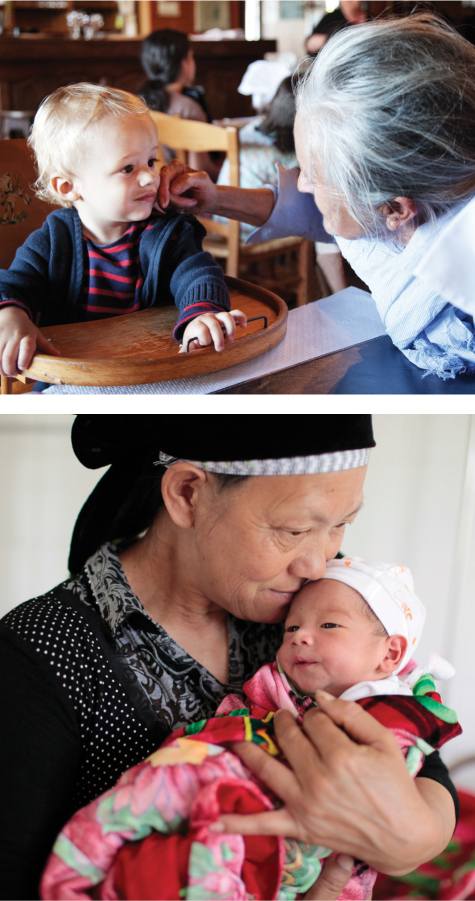
CHAU DOAN/LIGHTROCKET VIA GETTY IMAGES
The dependence is mutual. It is almost impossible not to dote on a baby who grins at the sight of your face and pays attention when you frown. Thus it is part of human nature for babies to evoke caregiving, and for caregivers to attend to babies.
AllocareEvolutionary social scientists note that if mothers were the exclusive caregivers of each child until children were adults, a given woman could bear only one or two offspring—
Compared to many other species, human mothers are willing to let other people help with child care, and other people are eager to do so (Kachel et al., 2011). Throughout the centuries, the particular person to provide allocare has varied by culture and ecological conditions. Often fathers helped, but not always. Some men were far away, fighting, or hunting, or seeking work; some had several wives and children. In those situations, other women (daughters, grandmothers, sisters, friends) and sometimes other men provided allocare. In several cultures, infants were breastfed by several lactating women, especially in the beginning before the mother’s milk became plentiful. All this can be explained by evolutionary theory. Of course, as you just read, other theories are plausible as well. Cultural variations in allocare are vast, and each theory can be used to justify certain variations.
Non-parental Care
It is estimated that about 134 million babies will be born each year from 2010 to 2021 (United Nations, 2011). Most newborns will be cared for primarily or exclusively by their mothers, with allocare increasing from ages 1 to 20. Some infants, even in the first months of life, are cared for by relatives, typically fathers in North America and grandmothers in most other nations (Leach, 2009). Worldwide, only about 15 percent of infants (birth to age 2 years) receive daily care from a non-
165
Many people believe that their own family’s or culture’s practices are best and that other patterns harm either the infant or the mother. This is another example of the difference-
Statistics on the precise incidence and consequences of various forms of infant care in each nation are difficult to find or interpret because it is difficult to keep statistics on the many different types of child care arrangements (Leach, 2009). Further, patterns of infant care are part of a complex web of child-
International ComparisonsCentre-
Involvement of relatives in infant care also varies. Worldwide, fathers are increasingly involved in baby care. Some nations provide paid leave at birth for fathers as well as mothers. Several nations provide paid family leave that can be taken by either parent or shared between them. Some nations mandate that a job be held for a woman who takes an unpaid maternity leave. Most developing nations provide limited paid leave for mothers (India does not allow women to be employed in the first six weeks after birth) but not fathers (see TABLE 4.4).
|
Note that these are policies, not always practices. In many nations, parents have intense, unregulated employment and take off only a day or two for birth. Also note that underlying such policies are theories about what is best for infants. When nations mandate paid leave, the belief is that infants need parental care and that employers should encourage that to occur.
In Canada, 70 percent of infants are cared for exclusively by their mothers (no other relatives or babysitters) throughout their first year (Côté et al., 2008). This is in contrast to the United States, which is similar in ethnic diversity but has higher rates of maternal employment: 20 percent of American infants are cared for only by their mothers. These differences are affected by culture more than by universal psychosocial needs of babies and parents. In the United States, federal policy mandates that a job be held for a parent who takes unpaid leave of up to 12 weeks unless the company has fewer than 50 employees, and almost no company pays for paternal leave. As a result, most mothers return to work soon after giving birth.
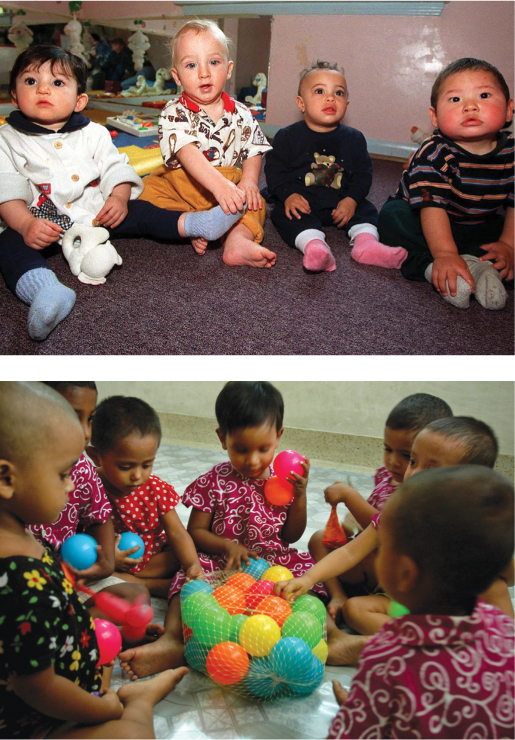
DOLI AKTER/AGE FOTOSTOCK
One might hope that centuries of maternal, paternal, and allocare would provide clear conclusions about effective practices. Unfortunately, the evidence is mixed.
Types of Non-
OBSERVATION QUIZ
What cultural differences do you notice? 
The Bangladeshi children are dressed alike and they are all of the same ethnicity. The children from Winnipeg are dressed differently and are of different ethnicities.
When parents turn to paid non-
166
Providing physical care and ensuring safety are only the beginning of quality caretaking, although those factors tend to be the focus when parents seek allocare. Evolutionary theory notes that survival of infants was far from guaranteed in earlier centuries. Ideally, each baby also experiences many hours each day of personalized social interaction.
Another option is centre daycare, in which licensed and specially educated adults care for several infants in a place especially designed for them. Most centres separate infants from older children, a good strategy from the humanist perspective, since it allows everyone’s developmental needs to be met. In Canada in 2003, about 28 percent of children between the ages of 6 months and 5 years attended a daycare centre funded by the province or territory. In Quebec, thanks to generous provincial subsidies that started in 1997, the rate was much higher at 52 percent (Bushnik, 2006).
Ideally, an infant daycare centre has ample safe space, appropriate equipment, trained providers, and two adults for a group of five or fewer infants (de Schipper et al., 2006; NAEYC, 2012) (see TABLE 4.5). Such a setting advances both cognitive and social skills: Babies are intrigued by other babies, and they learn from them.
High-
|
No matter what form of care is chosen, responsive, individualized care with stable caregivers seems best (Morrissey, 2009). Caregiver change is especially problematic for infants because it doesn’t allow synchrony to develop. Each simple gesture or sound that a baby makes not only merits an encouraging response, but also requires interpretation by someone who knows that particular baby well. “Baba” could refer to a bottle, baby, blanket, banana, or some other item that does not even begin with the /b/sound. This example emphasizes the importance of synchrony.
167
The Effects of Infant DaycareThe evidence is overwhelming that good preschool education (discussed in Chapter 5) benefits children, especially in cognition. However, as the National Institute of Child Health and Human Development (NICHD) states, when it comes to infants, disagreements about the merits of different forms of child care remain (NICHD Early Child Care Research Network, 2005). A major problem is that quality varies a great deal. Some caregivers with no training look after many infants, and the result is inadequate care.
Some babies seem far more affected than others by the quality of their care (Phillips et al., 2011; Pluess & Belsky, 2009). The main concern is that some infants with extensive non-
Consider three examples. First, in England, one study found that infants who were not exclusively in their mothers’ care were less advanced emotionally at age 5 years (Fergusson et al., 2008). Most of those infants were cared for by grandmothers, especially when the mothers were young and poor. As you know from your understanding of correlation, however, low SES itself is associated with several variables, in addition to non-
Second, a large study in Canada found that infant girls seem to develop equally well in various care arrangements. However, boys are more complex. Boys from high-
The opposite was true for boys from low-
ESPECIALLY FOR Daycare Providers A mother who brings her child to you for daycare says that she knows she is harming her baby, but economic necessity compels her to work. What do you say? 
Reassure the mother that you will keep her baby safe and will help develop the baby’s mind and social skills by fostering synchrony and attachment. Also tell her that her interactions with her baby will continue to be strong, which is most important for her baby’s psychosocial development. 
The third study may be the most solid research, in that it is longitudinal and began with a large and diverse sample. The Early Child Care Research Network of the NICHD has followed the development of more than 1300 children from birth to age 11 years. Researchers found many cognitive benefits of early daycare, especially in language development. Attachment to mothers seemed as secure for babies in daycare as for babies with exclusive maternal care. Some babies in infant care were also securely attached to their caregivers, which is a good sign.
Like other, smaller studies, the NICHD research confirms that the mother–
However, the NICHD study also found that infant daycare is detrimental when the mother is insensitive and the infant spends more than 20 hours a week in a poor-
168
What can be concluded from these three studies? Nothing definitive. Each study is complex: International variations, uncertainty about quality and extent of care (both at home and elsewhere), and the fact that choices are not random (for instance, maternal employment and hence allocare are more likely in families with educated parents, but less likely if the couple are married and financially secure) make general conclusions elusive.
Family income, culture, religion, and education affect choice of care, and those same variables affect child development. The fact that boys are more affected than girls may indicate something about biological sex, or that difficult boys are more often placed in daycare, or that cultures encourage traits in boys that are discouraged in girls. Indeed, not every study finds that boys are more affected—
Maternal Employment in InfancyClosely tied to the issue of infant daycare is the issue of maternal employment. Once it was assumed that mothers should stay home with their children, as recommended by psychoanalytic and behaviourist theory. That assumption has been challenged, partly by the idea that mothers have needs that merit attention (humanism), and by historical evidence that exclusive maternal care was far from typical over the centuries (evolutional theory).
A summary of the longitudinal outcomes of non-
A time-
There was no evidence that mothers’ time at work interfered with the quality of their relationship with their infants, the quality of the home environment, or children’s development. In fact, the results suggest the opposite. Mothers who spent more time at work provided slightly higher quality home environments.
[Huston & Aronson, 2005]
This is a comforting conclusion for employed mothers, but again other interpretations are possible. It may be that the women who were able to find worthwhile work were more capable of providing a quality home environment than the women who were unemployed. Further, the fact that employed mothers had less time with their husbands or less personal time for leisure may not bode well for the child’s future.
Marriage relationships benefit from shared activities, so couples who rarely enjoy each other’s company are likely to be less dedicated to each other. This may be particularly a problem for the men, because men who are devoted to their wives are more likely to be active and involved fathers. Father involvement correlates with child happiness and success. The opposite is also true.
169
As you see, every study reflects many variables, just as every theory has a different perspective on infant care. Given that, and given divergent cultural assumptions, it is not surprising that researchers find mixed evidence on infant care and caregivers. Many factors are relevant: infant sex and temperament, family income and education, and especially the quality of care at home and elsewhere.
Thus, as with many topics in child development, questions remain. What is definite is that each infant needs personal responsiveness from at least one person—
KEY Points
- All theories recognize that infant care is crucial: Psychosocial development depends on it.
- Psychoanalytic theory stresses early caregiving routines, with Freud and Erikson differing in specifics.
- Behaviourists emphasize early learning, and cognitive theories emphasize early thinking. In both cases, lifelong patterns are said to begin in infancy.
- Social learning focuses on how infants learn behaviours from their social environment, such as using role models.
- Family systems theory stresses the importance of all family members, such as fathers who also play an important role in their children’s lives.
- Humanists recognize that everyone—
adults as well as infants— have basic needs they seek to fulfill. - According to evolutionary theory, inborn impulses provide the interdependence that humans need for survival.
- Infant daycare and maternal employment are now common in North America, but worldwide they remain controversial.